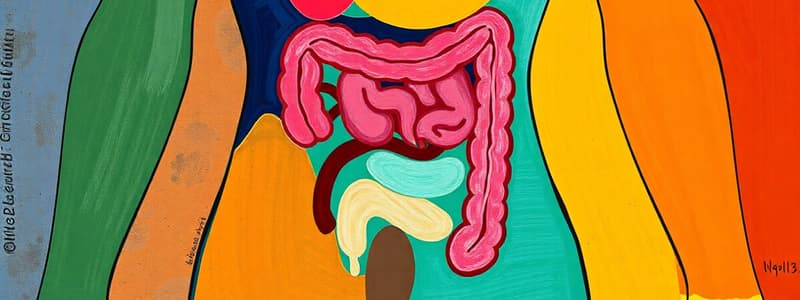Podcast
Questions and Answers
Which organ is primarily responsible for the movement of food through rhythmic waves known as peristalsis?
Which organ is primarily responsible for the movement of food through rhythmic waves known as peristalsis?
- Liver
- Intestines
- Stomach
- Esophagus (correct)
What is the primary function of bile secreted by the liver?
What is the primary function of bile secreted by the liver?
- Break up fat for absorption (correct)
- Movement of food through peristalsis
- Storage of waste material
- Chemical digestion of proteins
Which digestive organ is mainly involved in the absorption of nutrients through its large surface area?
Which digestive organ is mainly involved in the absorption of nutrients through its large surface area?
- Rectum
- Pancreas
- Small intestine (correct)
- Stomach
Which organ performs both physical and chemical digestion of proteins?
Which organ performs both physical and chemical digestion of proteins?
What role does the pancreas play in the digestive system?
What role does the pancreas play in the digestive system?
Flashcards
What is the function of the esophagus?
What is the function of the esophagus?
The muscular tube that connects the mouth to the stomach, moving food down by rhythmic waves called peristalsis.
What is the function of the liver in digestion?
What is the function of the liver in digestion?
A large organ that secretes bile, which helps break down fats for absorption in the intestines.
What happens to food in the stomach?
What happens to food in the stomach?
A muscular organ that churns food and mixes it with digestive juices to break down proteins, assisted by enzymes.
What are the functions of the small and large intestines?
What are the functions of the small and large intestines?
Signup and view all the flashcards
What is the digestive function of the pancreas?
What is the digestive function of the pancreas?
Signup and view all the flashcards
Study Notes
Digestive Organs and Functions
- Mouth: Physical digestion (teeth, tongue, saliva) and chemical digestion (salivary enzymes) of sugars.
- Esophagus: Movement of food via peristalsis (rhythmic waves).
- Stomach: Physical digestion (churning, mixing with digestive juices, acids, enzymes) and chemical digestion (protein breakdown).
- Liver: Secretes bile, aiding fat absorption into the intestine.
- Pancreas: Secretes pancreatic juice, insulin, and enzymes into the intestine.
- Intestines: Completes chemical digestion using enzymes. Reabsorbs water and absorbs nutrients through the large intestine's large surface area.
- Small Intestine: Chemical digestion completion, water reabsorption, nutrient absorption via large surface area, and onward transport to the large intestine.
- Large Intestine: Absorption of remaining nutrients; stores waste until elimination.
- Rectum and Anus: Storage and elimination of waste.
Studying That Suits You
Use AI to generate personalized quizzes and flashcards to suit your learning preferences.




